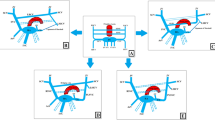Abstract
Port catheters have been increasingly used in recent years. Using one case as an example, we demonstrate how an anatomic variation can easily become a pitfall when inserting a central venous catheter, port catheter, pacemaker or Swan-Ganz catheter. We report a case of persistent left superior vena cava, the most common variation in the thoracic venous system. Since these procedures are increasingly being performed, surgeons, anesthesiologists and radiologists should be aware of the possible anatomic variations. The French version of this article is available in the form of electronic supplementary material and can be obtained by using the Springer Link server located at http://dx.doi.org/10.1007/s00276-002-0088-4.
Résumé
Les cathéters portes ont été utilisés de plus en plus lors des dernières années. A l'aide d'un cas clinique, nous démontrons comment une variation anatomique peut aisément devenir un piège au cours de l'insertion d'un cathéter veineux central, d'un cathétérisme porte, de la mise en place d'un pacemaker ou de la pose d'une sonde de Swan-Ganz. Nous rapportons un cas de veine cave supérieure gauche persistante, la plus commune des variations du système veineux thoracique. Depuis que ces techniques sont de plus en plus utilisées, les chirurgiens, les anesthésistes et les radiologues devraient être avertis de la possibilité de ces variations anatomiques.




Similar content being viewed by others
References
Biffi M, Boriani G, Frabetti L, Bronzetti G, Branzi A (2001) Left superior vena cava persistence in patients undergoing pacemaker or cardioverter-defibrillator implantation: a 10-year experience. Chest 120: 139–144
Bothe A, Piccione W, Ambrosino JJ, Benotti PN, Lokich JJ (1984) Implantable central venous access system. Am J Surg 147: 565–569
Browse NL, Burnand KG, Thomas ML (1988) Diseases of the veins. Stoughton, London, pp 23–31
Gyves JW, Ensminger WD, Niederhuber JE, Dent T, Walker S, Gilbertson S, Cozzi E, Saran P (1984) A totally implanted port system for blood sampling and chemotherapy administration. JAMA 251: 2538–2541
Gyves JW, Ensminger W, Niederhuber J, Liepman M, Cozzi E, Doan K, Dakhil S, Wheeler R (1982) Totally implanted system for intravenous chemotherapy in patients with cancer. Am J Med 73: 841–845
Josloff RK, Kukora JS (1995) Central venous catheterization via persistent left superior vena cava. Am Surg 61: 781–783
Kock HJ, Krause U, Pietsch M, Rasfeld S, Walz MK (1996) Implantable catheter systems. Experiences with 1,000 patients with central venous ports. Dtsch Med Wochenschr 121: 47–51
Ludwig CU, Stoll HR, Obrist R, Obrecht JP (1987) Prevention of cytotoxic drug-induced skin ulcers with dimethyl sulfoxide (DMSO) and Tocopherole. Eur J Clin Oncol 23: 327–329
Probst M, Jooss D, Salomon F (1996) Eine neue Technik zur Implantation von Venen-Port-Systemen. Chirurgie 67: 563–564
Sadler TW (1995) Langman's medical embryology, 7th edn. Williams and Wilkins, Baltimore, pp 212–224
Sakamoto H, Akita K, Sato K, Sato T (1993) Left superior vena cava continuing to the accessory hemiazygos without anastomosis with the coronary sinus. Surg Radiol Anat 15: 151–154
Spiegel RJ (1981) The acute toxicities of chemotherapy. Cancer Treat Rev 8: 197–207
Strum S, McDermed J, Korn A, Joseph C (1986) Improved methods for venous access: Porth-A-Cath, a totally implanted catheter system. J Clin Oncol 4: 596–603
Zerbe F, Bornakowski J, Sarnowski W (1992) Pacemaker electrode implantation in patients with persistent left superior vena cava. Br Heart J 67: 65–66
Author information
Authors and Affiliations
Corresponding author
Additional information
The French version of this article is available in the form of electronic supplementary material and can be obtained by using the Springer Link server located at http://dx.doi.org/10.1007/s00276-002-0088-4
Rights and permissions
About this article
Cite this article
Schiffmann, L., Kruschewski, M., Wacker, F. et al. Persistent left superior vena cava: a reason for pseudodisplacement of a port catheter. Surg Radiol Anat 25, 70–72 (2003). https://doi.org/10.1007/s00276-002-0088-4
Received:
Accepted:
Published:
Issue Date:
DOI: https://doi.org/10.1007/s00276-002-0088-4




